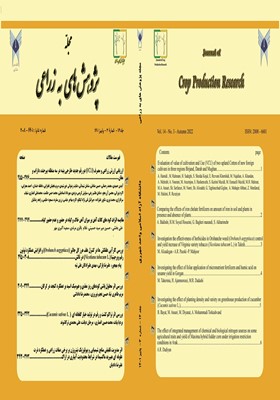اثر مدیریت تلفیقی منابع شیمیایی و بیولوژیک نیتروژن بر برخی صفات زراعی و عملکرد ذرت علوفهای هیبرید ماکسیما در شرایط محدودیت آبیاری در اراک
محورهای موضوعی : پژوهش های به زراعی
1 - دانشیار
کلید واژه: نیتروژن, تنش کم آبی, نیتروکسین, ذرت علوفه ای هیبرید ماکسیما,
چکیده مقاله :
این پژوهش با هدف بررسی کاربرد تلفیقی منابع بیولوژیکی و شیمیایی نیتروژن تحت شرایط محدودیت منابع آبی بر برخی صفات زراعی و نیز عملکرد علوفه تر در سال های زراعی 1395 و 1396 در اراک انجام شد. این آزمایش به صورت اسپلیت اسپلیت پلات و در قالب طرح پایه بلوک های کامل تصادفی در چهار تکرار انجام شد به طوری که سطوح آبیاری در کرت اصلی و سطوح نیتروکسین و نیتروژن در کرت های فرعی قرار گرفت. عوامل مورد بررسی عبارت بودند از آبیاری در دو سطح آبیاری متداول و محدودیت آبی، نیتروکسین در سه سطح تیمار شاهد، مصرف 0/5 و یک لیتر نیتروکسین به ازاء 30 کیلوگرم بذر مصرفی و نیتروژن در سه سطح شامل تیمار شاهد، مصرف 125 و 250 کیلوگرم نیتروژن در هکتار از طریق کود اوره 46 درصد. اثر متقابل آبیاری و نیتروکسین بر کلیه صفات اندازه گیری شده غیر از تعداد ردیف در بلال و تعداد دانه در بلال معنی دار شد و با کاربرد یک لیتر نیتروکسین تحت شرایط آبیاری متداول بیشترین مقدار این صفات نتیجه شد. در شرایط اعمال محدودیت آبیاری، مصرف یک لیتر نیتروکسین در مقایسه با کاربرد 0/5 لیتر آن و نیز تیمار بدون کاربرد نیتروکسین افزایش کمی کلیه ی صفات مورد بررسی را نتیجه داد. اثر متقابل آبیاری و نیتروژن بر تمامی صفات مورد مطالعه بجز تعداد بلال در گیاه و تعداد کل دانه در گیاه معنی دار بود به نحوی که بیشترین مقدار صفات تاثیر پذیر، از مصرف 250 کیلوگرم نیتروژن تحت شرایط آبیاری متداول به دست آمد. اثر متقابل نیتروکسین و نیتروژن بر سایر صفات معنی دار شد. بیشترین تعداد بلال در گیاه و عملکرد علوفه تر (با میانگین 86/42 تن در هکتار) در اثر مصرف یک لیتر نیتروکسین توام با 250 کیلوگرم نیتروژن در هکتار به دست آمد ولی در خصوص سایر صفات بیشترین میانگین آن ها در اثر مصرف یک لیتر نیتروکسین همراه با 125 کیلوگرم نیتروژن در هکتار حاصل گردید.
This research was conducted with the aim of investigating the combined use of biological and chemical nitrogen sources under the conditions of limited water resources on some agricultural traits and the yield of fodder in the crop years of 2016 and 2017 in Arak. This experiment was done in the form of a split-split plot and in the form of a basic design of randomized complete blocks in four replications, so that irrigation levels were placed in the main plot and nitroxin and nitrogen levels were placed in the sub-plots. The investigated factors were irrigation at two levels of regular irrigation and water restriction, nitroxin at three levels of the control treatment, consumption of 0.5 and one liter of nitroxin per 30 kg of seeds consumed and nitrogen at three levels including the control treatment, consumption of 125 and 250 kg of nitrogen per hectare through 46% urea fertilizer. The interaction effect of irrigation and nitroxine on all the measured traits except the number of rows in the cob and the number of seeds in the cob was significant, and with the application of one liter of nitroxine under normal irrigation conditions, the highest amount of these traits was obtained. In the conditions of applying irrigation restrictions, the consumption of 1 liter of nitroxin compared to the application of 0.5 liters and also the treatment without the use of nitroxin resulted in a slight increase in all investigated traits. The interaction effect of irrigation and nitrogen was significant on all studied traits except the number of cobs in the plant and the total number of seeds in the plant, so that the highest amount of effective traits was obtained from the consumption of 250 kg of nitrogen under normal irrigation conditions. The interaction effect of nitroxin and nitrogen on other traits was significant. The highest number of cobs per plant and higher fodder yield (with an average of 86.42 tons per hectare) were obtained as a result of the consumption of one liter of nitroxin combined with 250 kg of nitrogen per hectare, but regarding other traits, the highest average results were obtained from the consumption of one liter of nitroxin. along with 125 kg of nitrogen per hectare.
_||_

